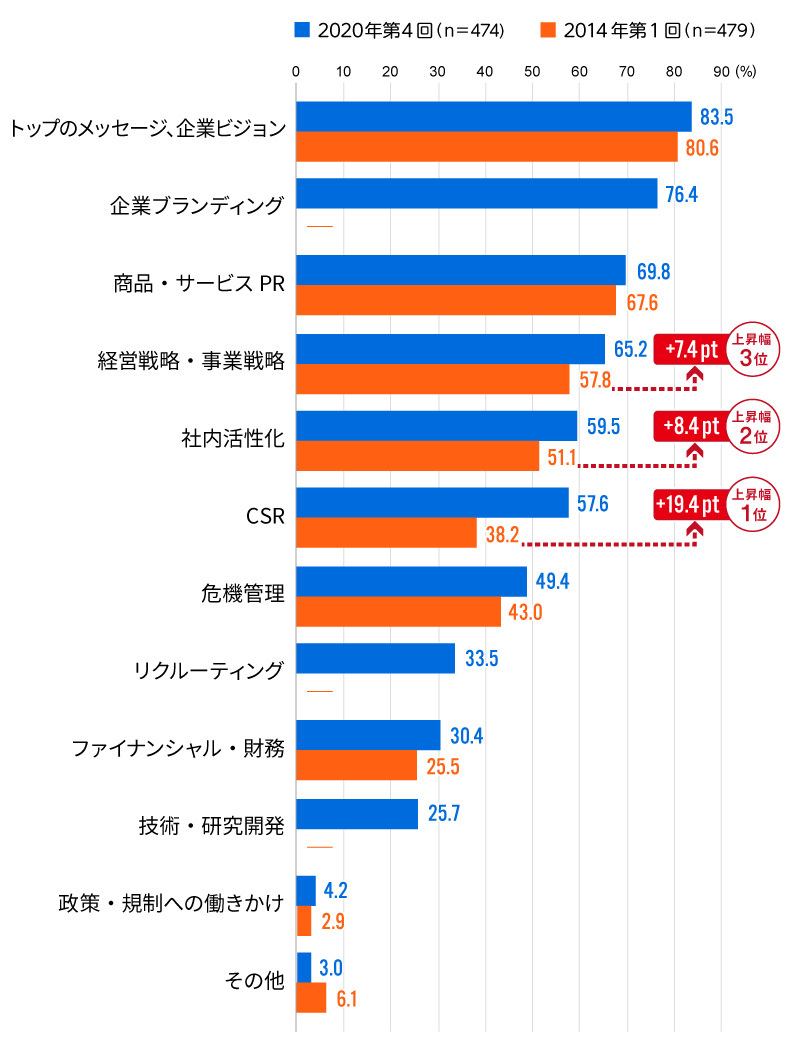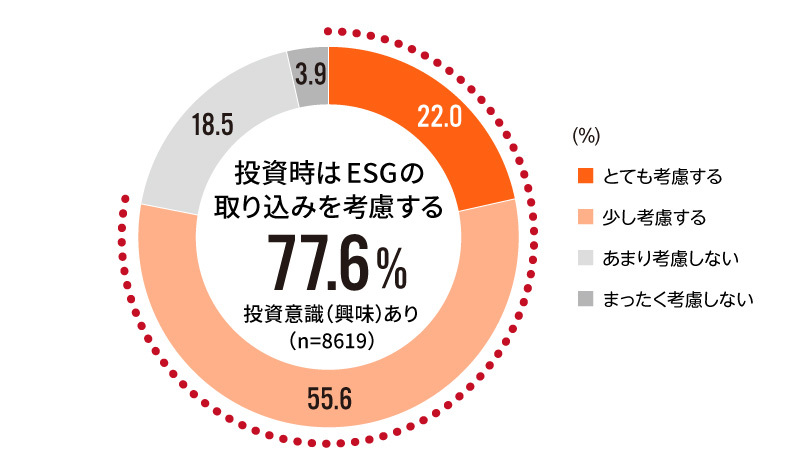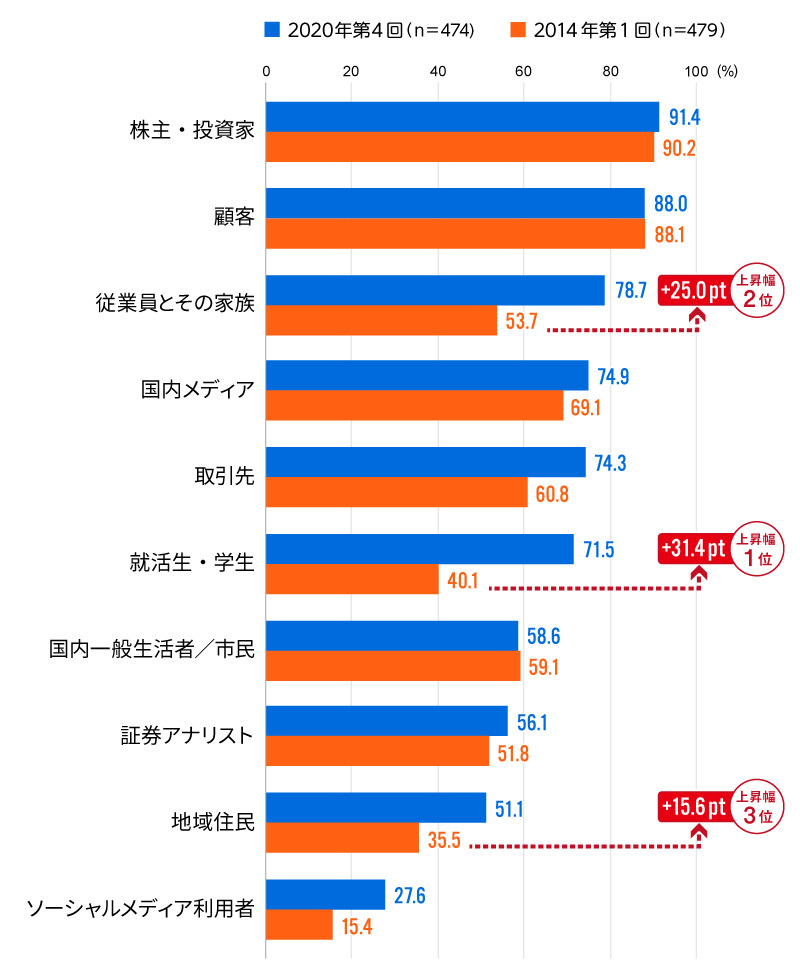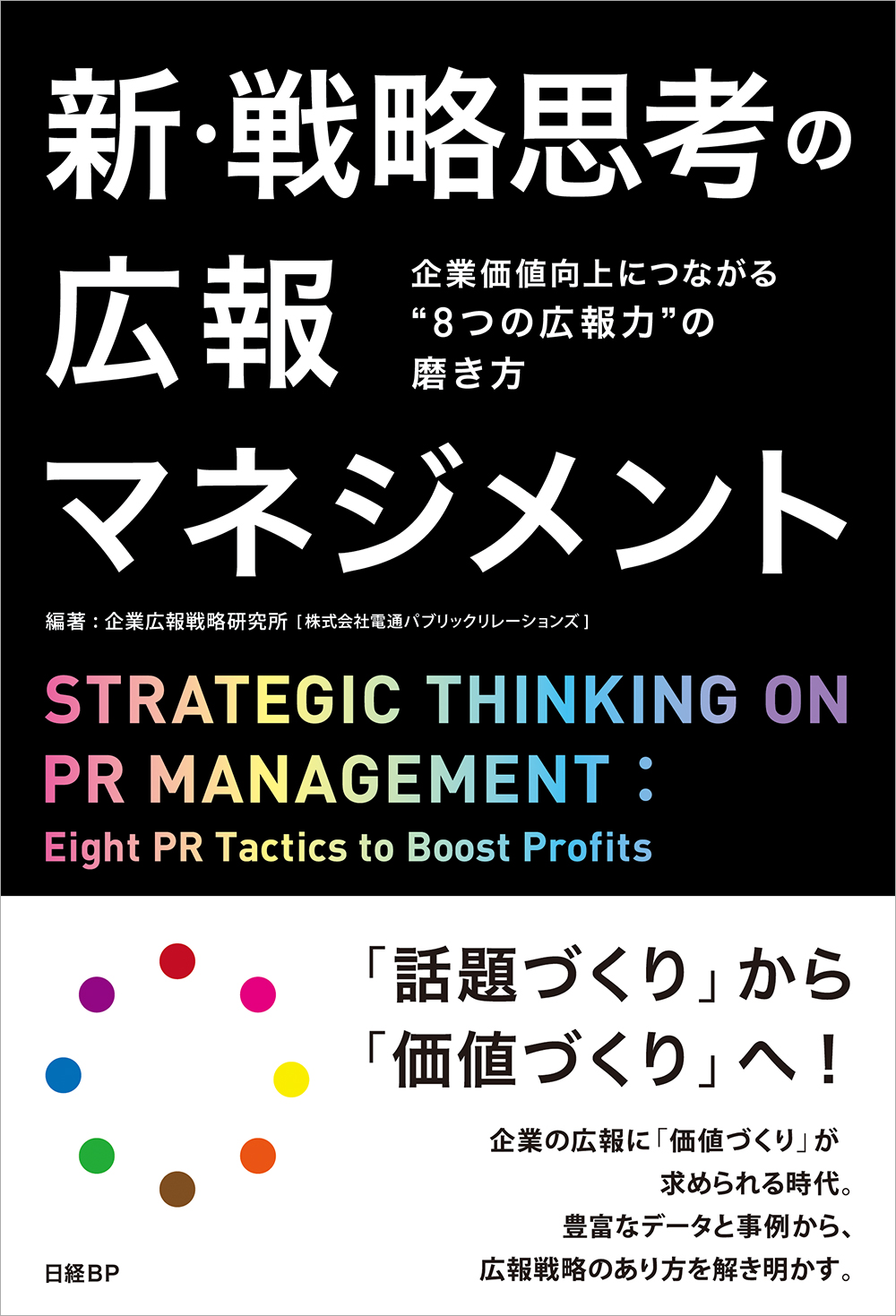Following the COVID-19 pandemic, changes in the corporate business environment have accelerated, demanding that the mission of public relations and PR activities evolve accordingly.
The Corporate Public Relations Strategy Institute (abbreviated as C.S.I., within Dentsu Inc. PR) has conducted regular surveys targeting heads of corporate PR and communications departments to research how the roles and functions of PR departments should evolve.
Based on these findings, we published the book "New Strategic Thinking in PR Management " (Nikkei BP), focusing on the theme of "value-creating PR." This series will introduce what "value-creating PR" means for companies moving forward.
The Mission of PR Continues to Evolve with the Times
According to our institute's survey results, the activity themes companies consider for their PR departments are as shown in Figure 1.
[Figure 1: Key Themes for PR Departments]
Q. What are the PR themes your department handles?

*Some activity themes were not included in the questionnaire items during the first survey.
Ranked first consistently from the 1st to the 4th survey is "Top Management Messages/Corporate Vision." This confirms it as the most critical theme in public relations and PR.
The theme with the largest increase over the six years since 2014 was "CSR" (6th place). Conversely, the theme with the smallest increase was "Product/Service PR" (3rd place). This demonstrates how corporate PR missions continue to evolve with the times.
The mission has shifted from "creating buzz" to "creating value." What are the three reasons behind this?
Since its establishment in 2013, the Corporate Public Relations Strategy Institute has conducted surveys and interviews on the actual state of corporate PR activities for a total of approximately 2,000 companies. Based on these research findings, we believe the mission of PR has shifted from "creating buzz" to "creating value."
Three major reasons underlie this shift:
① Information has a shorter shelf life
The COVID-19 pandemic has accelerated the digital transformation (DX) of media and information environments, significantly impacting the PR world.
On the media side, the volume of information dissemination has increased dramatically due to the rise of web news with unlimited information capacity and video-sharing sites. For consumers receiving this information, the diversification of media and devices, coupled with improved network environments like 5G, has created an era where people are constantly exposed to information.
Amidst the daily flood of vast amounts of information, you may also feel that even when offering fleeting topics, their "shelf life" has become extremely short.
Therefore, to increase the "yield" of information, what is needed is "value creation" by the entities disseminating the information, such as companies.
One of the most critical tasks for public relations and communications departments is "reading the currents of society." By anticipating qualitative and emotional "currents" in society—such as expectations, anxieties, and frustrations—and feeding this insight back into the company, they aim to create facts that resonate with society. This "value creation" ultimately builds trust and enhances the company's reputation.
To achieve this, it is crucial to read these trends faster than any competitor and be the first to challenge the creation of "valuable facts."
For example, consider the café chain that swiftly responded to growing societal concern about ocean plastic waste by switching to paper straws, or the electronics manufacturer that was among the first to ramp up mask production during the COVID-19 pandemic. Companies that quickly address societal anxieties and expectations earn trust and empathy, leading people to pay attention to the information they communicate.
Going forward, PR departments will need to enhance their foresight and adopt a mindset focused on producing valuable facts for stakeholders.
② The Full-Scale Adoption of ESG
According to our institute's survey, 77.6% of people consider a company's ESG (Environment, Social, Governance) initiatives when making investment decisions (see Figure 2).
[Figure 2: Considering Companies' ESG Initiatives When Investing]

While financial metrics like sales and ROE (Return on Equity) are certainly important as measures for evaluating corporate value, engaging with ESG is crucial for companies to be continuously evaluated as viable medium- to long-term investment targets.
Indeed, the number of companies holding "ESG briefings" to communicate their integrated value, alongside earnings briefings, is rapidly increasing, and this trend is expected to accelerate further.
Our research institute believes there are three major types of "value" companies should communicate (see Figure 3).
- "Product Value"
This is the direct point of contact with customers, where convenience, quality, and other aspects are emphasized to help customers experience the value being provided.
- Market Value
Primarily targeting shareholders and investors, this communicates the company's growth potential and demonstrates its vitality.
- "Social Value"
The core value of the company, gained by collecting stakeholder feedback and incorporating it into corporate management to earn society's trust.
While ESG initiatives primarily contribute to market value, it is crucial to recognize that social value is inherently embedded within both market value and product value.
To continuously earn society's trust, it is necessary to re-examine the company's social value, create facts that connect to social value, and engage in information disclosure and communication.
[Figure 3: Value Companies Should Communicate]
③ From Shareholders to Stakeholders
On August 19, 2019, the U.S. business organization "Business Roundtable" declared a shift from shareholder primacy to "stakeholder capitalism." It stated that companies are accountable not only to shareholders but also "to customers, employees, suppliers, communities, and shareholders."
Furthermore, it emphasized that companies should aim not only to maximize their own profits but also to realize their purpose.
A similar theme was also addressed at the 2020 Davos Conference.
Our institute's survey also reflects this global trend. Significant changes are evident in the responses to the question asking corporate PR officers about their "prioritized stakeholders/targets" (multiple answers allowed).
The 2020 survey results, as shown in Figure 4, were:
1st place: Shareholders/Investors
2nd place: Customers
3rd place: Employees and their families
4th place: Media
Figure 4: Top 10 Most Important Stakeholders/T
[Figure 4: Top 10 Prioritized Stakeholders/Targets]
For the first time since the 2014 survey, "Media" dropped to 4th place. "Employees" in 3rd place have increased their score every year since the first survey, rising by 25.0 points over six years. Additionally, "Business Partners" in 5th place have also gradually increased their score, closing the gap with Media to just 0.6 points.
This data reveals the following:
The key mission of public relations and PR activities has evolved beyond merely "creating buzz" through the media to building strong relationships (relationship-building) with stakeholders critical to the company.
Our institute has defined three representative approaches for successful "value creation" PR as follows:
- Pursuing "social value" centered on the primary target: "1st place: Shareholders/Investors. "
- Building "engagement" with the key target group "2nd Place: Customers. "
- Practicing "Internal Branding" with the key target group "3rd: Employees and Their Families."
Details on these "Three Approaches" will be discussed next time.
The "Integrated Thinking" PR Departments Must Master for "Value Creation"
Finally, I will discuss the "thinking necessary for value-creating PR." That is "integrated thinking."
In PR and communications, "integrated thinking" means
the ability to plan and produce compelling value based on facts buried throughout the company.
.
The PR department possesses the ultimate weapon: "information." Accurately grasping and anticipating the expectations and concerns of key stakeholders, feeding this insight back into the company, and further creating synergy with external parties—this mindset of producing corporate "value creation" is indispensable for the PR department going forward.
In other words, under this "integrated thinking" that transcends internal departmental boundaries and even integrates external resources, the PR department should function as a producer that elevates corporate value.
[Survey Overview]
■Corporate PR Capabilities Survey
Survey Period: May 22, 2020 - August 7, 2020
Survey Target: Companies listed on the Tokyo Stock Exchange First Section, Second Section, Mothers, JASDAQ, Sapporo Securities Exchange, Nagoya Stock Exchange, and Fukuoka Stock Exchange at the time of publication in "Company Quarterly Report 2020" (3,679 companies)
Valid Responses: 474 companies (response rate: 12.9%)
Survey Method: Mail and online survey
Survey Sponsor: Corporate Public Relations Strategy Institute (within Dentsu Inc. Public Relations Inc.)
*Figures in this survey are rounded to the nearest whole number.
■ESG/SDGs Survey
Survey Participants: 10,500 men and women aged 20 to 69 nationwide
Survey Method and Period: Online survey: June 24–30, 2020
Questions: Awareness of ESG/SDGs, expected corporate SDGs initiatives, degree of ESG consideration in investment decisions, etc.
Survey Participants
 *This survey rounds figures to the nearest whole number.
*This survey rounds figures to the nearest whole number.






 *This survey rounds figures to the nearest whole number.
*This survey rounds figures to the nearest whole number.
